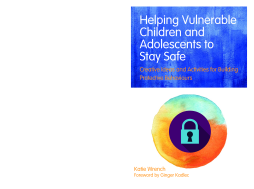
Additional Information
Book Details
Abstract
Helping vulnerable children and young people to build protective behaviours is the key to keeping them safe.
Full of creative ideas and activities, this guide provides the tools to help children develop these key skills. Topics include work around: building resilience and problem solving skills; identifying a 'safety network'; developing emotional literacy; awareness of grooming strategies and safe/unsafe touch; and cyber safety. The range of tried and tested techniques will be sure to engage any child in thinking about their personal safety, allowing adult carers to have confidence that their child will be empowered to better identify and avoid harmful situations and behaviours.
Practical and easy to use, this is a valuable resource for professionals working with vulnerable children and young people, such as adopted or fostered children and those in residential care, as well as the parents and carers of these children.
Nestled at the heart of child-centred practice, brimming with easy-to-do ideas, this book is a fantastic resource for practitioners in all sectors working with children. While acknowledging traumatic experiences including child sexual abuse and children entering the care system, the many examples from practice bring the creative, cost-free activities to life. This book enables children to engage with Protective Behaviours, so they can explore ways to feel safer and know they can always talk with someone if feeling unsafe.
Judith Staff, Protective Behaviours Trainer and Specialist Practitioner, UK
Helping Vulnerable Children and Adolescents to Stay Safe is an essential text for educators, carers and any professionals who work with children. The easy-to-follow activities and protective behaviours information are vital in helping us as a society to protect children from all forms of abuse. Prevention education is crucial to the well-being of children and I highly recommend Helping Vulnerable Children and Adolescents to Stay Safe for its age-appropriate and practical tasks. The information and skills children will receive via this book are both empowering and essential.
Jayneen Sanders, Author of 'Some Secrets Should Never Be Kept' and 'No Means No!', Australia
Katie Wrench is a qualified therapeutic social worker, art psychotherapist and foster carer. She works with children and young people who are fostered or adopted and provides specialist consultation and training to frontline social care practitioners and foster carers around life story work. Katie is co-author of Life Story Work with Children Who are Fostered or Adopted, also published by Jessica Kingsley Publishers. She is based in Leeds, UK.
Table of Contents
| Section Title | Page | Action | Price |
|---|---|---|---|
| Helping Vulnerable Children and Adolescents to Stay Safe: Creative Ideas and Activities for Building Protective Behaviours by Katie Wrench | 3 | ||
| Foreword | 7 | ||
| Acknowledgements | 10 | ||
| Introduction | 11 | ||
| Chapter 1 - Building Resilience and Self-esteem | 24 | ||
| Introduction | 24 | ||
| How I Make Myself Feel Better | 30 | ||
| Strengths Based All About Me | 31 | ||
| I’m the Greatest | 33 | ||
| Feel Good Notebook | 34 | ||
| The Tree | 36 | ||
| Self-esteem Time Line | 37 | ||
| Chapter 2 - Emotional Literacy and the Body’s Emotional Communication | 40 | ||
| Introduction | 40 | ||
| Identifying Early Warning Signs | 44 | ||
| Playing Feelings Detective | 48 | ||
| My House or My Castle | 50 | ||
| Feelings Charades | 52 | ||
| Feelings Rocket | 54 | ||
| Weather Report | 56 | ||
| Sense Memory | 58 | ||
| Chapter 3 - Feeling Safe and Understanding What it Means | 60 | ||
| Establishing Personal Networks | 64 | ||
| Safety Rules | 67 | ||
| Safety Continuum | 71 | ||
| Sensory Book of Safety | 74 | ||
| My Safe Place | 77 | ||
| Relaxation Techniques | 80 | ||
| Tuning in to Your Body | 85 | ||
| Chapter 4 - Body Awareness and Boundaries | 87 | ||
| Healthy Touching House Rules | 92 | ||
| My Own Space | 94 | ||
| Animal Boundaries | 95 | ||
| The Boundary Line | 97 | ||
| Body Tracing | 99 | ||
| Private versus Public Spaces and Places | 100 | ||
| Exploring Touch | 105 | ||
| Responding to Action Words | 107 | ||
| Chap[ter 5 - Developing Problem-solving Skills | 110 | ||
| Introduction | 110 | ||
| Alternative Simon Says | 116 | ||
| Self-Protection and Soothing | 117 | ||
| Child Safety Plan | 119 | ||
| Secrets and Secret Enablers | 121 | ||
| Stepping Stones | 125 | ||
| Preference and Choice | 126 | ||
| Chapter 6 - Working with Vulnerable Adolescents | 128 | ||
| Introduction | 128 | ||
| Wall or Tree of Hope | 140 | ||
| Jargon Buster | 141 | ||
| Relationships: Me and Other People | 143 | ||
| Self-Sabotage | 144 | ||
| Understanding Emotional Grooming | 146 | ||
| Normal or Harmful? Resisting Grooming Tactics | 149 | ||
| Chapter 7 - Online Safety | 151 | ||
| Introduction | 151 | ||
| What Else Helps? | 154 | ||
| Five SMART Rules for Primary-Aged Children | 160 | ||
| Family Internet Agreement | 162 | ||
| Virtual Relationships | 164 | ||
| Help and Support | 166 | ||
| Recommended Books for Children | 170 | ||
| References | 174 | ||
| Index | 178 | ||
| Blank Page |
